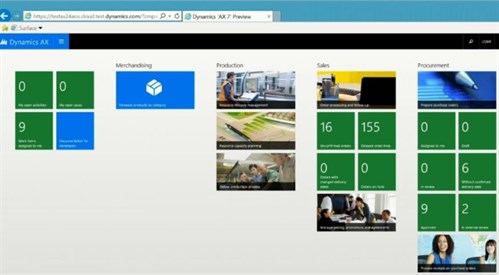What does the upcoming release of Microsoft Dynamics AX, launched in the cloud first, supported with industry-specific functionality and apps from To-Increase, mean for businesses? In addition to cost savings and efficiencies, improved scalability and security, extending ERP into a collaborative environment will open many opportunities for companies and their customers and trading partners. Recent reporting on the state of ERP confirms that more and more businesses understand that ERP in the cloud is to their advantage. Here’s a summary of the main reasons cloud-based ERP is a good thing.
Multisite ERP projects and cloud deployments on the increase
The recently released 2015 ERP Report by Panorama Consulting Solutions, the widely respected ERP consulting organization, provides a fascinating snapshot of companies’ experiences with their ERP systems. Manufacturers, by the way, represent 43 percent of the respondents to the survey that the report is based on.
85 percent of the companies surveyed implemented ERP systems at multiple locations, and almost a third of them deployed ERP across four or five manufacturing sites, offices, distribution centers, or other places of business. That would favor cloud-based over on-premise deployments. In 2014, 85 percent of the companies reported an on-premise implementation. In the current overview, that number has gone down dramatically, to 56 percent. 44 percent take advantage of cloud-based ERP, including software-as-a-service (SaaS) offerings.
The companies deciding against cloud ERP indicated that, other than not being well-informed regarding ERP cloud solutions, they were mostly concerned about the risks of data loss and security breaches. Panorama points out that according to its experience, those are misconceptions, and that today’s cloud solutions are typically reliable and secure.
These findings highlight the opportunity for ERP providers and ISVs in delivering cloud-based solutions. The upcoming release of Microsoft Dynamics AX, known as AX 7, will be available for public and private cloud deployments before the on-premise version reaches the market. It will also be designed for productive mobility, with a consistent application experience across mobile devices as well as standard desktop and laptop computers.
Cloud ERP’s greatest breakthroughs
Why do we think ERP in the cloud is such a good idea? Here are the main reasons.
#1. ERP everywhere, all the time
You can access ERP functionality and data from any device, any location, at any time. Responsive design enables consistent cross-device productivity.
#2. Cost savings
You don’t need to purchase software licenses or additional hardware, and you may be able to reduce your administrative overhead as well. If your line of business is manufacturing or construction and running a data center is not part of your mission, the cloud lets you focus on what matters most. The savings can be substantial. In the Panorama Consulting survey, 56 percent of the companies that went for cloud ERP reported savings of 41 to 60 percent compared to on-premise deployment.
#3. Ready for use
There is no longer a need for a lengthy ERP deployment of many months. When your ERP provider readies the solution, your users can access it. Your time-to-value is a fraction of what it might have been with a traditional, on-premise implementation.
#4. Simple upgrades
Solution upgrades and enhancements are similarly uncomplicated. Your IT team does not have to perform the testing and roll-outs. It’s part of the ERP service and, from the user perspective, takes place in the background. When the new software version or functionality is installed and configured at the ERP data center, it can be made available to users.
#5. Truly scalable
Compared to an on-premise deployment, the scalability and flexibility of cloud ERP is virtually unlimited. When you need to add individual users, new roles, business groups, or locations, your ERP provider can give them access to the solution. If you need additional functionality, turning on the right modules is a simple step. When an increase in workloads and transactions requires greater processing power and more data storage, the hosting data center can augment your allocations.
#6. Optimized for your industry
Along with Microsoft, To-Increase will deliver cloud-based capabilities for the industries and markets we support, including manufacturing, equipment rental, lease, architectural, engineering, and construction (AEC) companies, and government contracting. In the cloud, it becomes very easy to provision your ERP environment with tested, reliable functionality that your industry and business processes require.
#7. Socially connected
Because social media are naturally cloud-based, ERP in the cloud has a great synergy with them. Users can enjoy the immediacy of drawing on their peers’ expertise or connecting with customers and partners, in the moment when it matters most.
#8. Safe
The security of your data and applications in the cloud can be both more stringent and flexible in accommodating different user groups than it might be on-premise. Because information protection is an overriding concern for most businesses, cloud providers commit huge resources to the security of their infrastructure and the integrity of data and solution. They also can incorporate your company’s specific security policies in the cloud. In any case, you gain enterprise-level security at a reasonable cost.
#9. Forum for collaboration
The cloud is the perfect vehicle for collaborating with your customers, vendors, and trading partners, especially when you can connect product lifecycle management (PLM) and other systems with your ERP solution. When you link ERP and the internet of things (IoT), much more becomes possible. The technology makes it easy to give the right parties secure access to, for example, IoT data that show how equipment and machinery perform under certain conditions, or how buildings and bridges hold up under use- and climate-related stress. People in different organizations can engage through cloud and social channels to improve architectural designs, co-innovate new products, or almost anything they set their mind to.
#10. Responsive to customers
The cloud makes it much easier to plan, build, and evolve systems of engagement that provide the high-quality, rich, digital customer experience your company may want to deliver. Without a huge drain on your budget and resources, you can connect, configure, and fine-tune the different technologies and data sources that are the building blocks of a system of engagement.
It wasn’t all good news in Panorama Consulting’s 2015 report. Only 37 percent of the included companies are satisfied with their ERP vendors, only 69 percent would choose their ERP software again, and only 58 percent of them consider their implementation a success. It’s unfortunate that companies still expend resources and efforts on ERP projects that don’t deliver for them. However, with more usable, flexible, and powerful ERP, optimized for specific industries and business models, and with the resilience and scalability of the cloud, we can dismantle those sad statistics.

If you have any feedback or questions, or want to talk about cloud infrastructure planning, I’d love to talk with you. Get in touch with me or contact To-Increase.
Do you want to get started today? Start your transformation into the cloud today with our free whitepaper.





